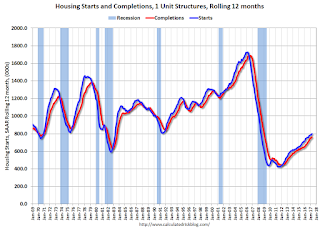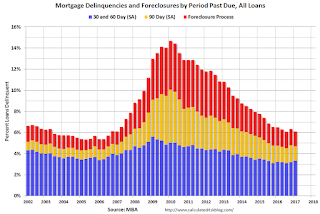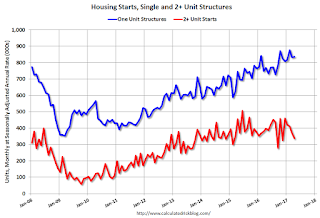by Calculated Risk on 5/17/2017 07:00:00 AM
Wednesday, May 17, 2017
MBA: "Mortgage Applications Decrease in Latest Weekly Survey"
From the MBA: Mortgage Applications Decrease in Latest MBA Weekly Survey
Mortgage applications decreased 4.1 percent from one week earlier, according to data from the Mortgage Bankers Association’s (MBA) Weekly Mortgage Applications Survey for the week ending May 12, 2017.
... The Refinance Index decreased 6 percent from the previous week. The seasonally adjusted Purchase Index decreased 3 percent from one week earlier. The unadjusted Purchase Index decreased 3 percent compared with the previous week and was 9 percent higher than the same week one year ago. ...
The average contract interest rate for 30-year fixed-rate mortgages with conforming loan balances ($424,100 or less) remained unchanged at 4.23 percent, with points increasing to 0.37 from 0.31 (including the origination fee) for 80 percent loan-to-value ratio (LTV) loans.
emphasis added
 Click on graph for larger image.
Click on graph for larger image.The first graph shows the refinance index since 1990.
Refinance activity remains low - and will not increase significantly unless rates fall sharply.
 The second graph shows the MBA mortgage purchase index.
The second graph shows the MBA mortgage purchase index. Even with the increase in mortgage rates late last year, purchase activity is still up 9% year-over-year.
Tuesday, May 16, 2017
Wednesday: Q1 2017 Household Debt and Credit Report
by Calculated Risk on 5/16/2017 07:38:00 PM
From Matthew Graham at Mortgage News Daily: Mortgage Rates Back at 2-Week Lows
Compared to yesterday, mortgage rates are either a little bit higher or lower depending on the lender at the moment. On average, they've inched just past last Friday's levels, meaning they're the lowest in 2 weeks.Thursday:
As nice as that sounds, it's worth noting that we're really splitting hairs here. Most anyone pricing out a mortgage right now won't see any difference in their rate quote over the past few days. The biggest drop occurred last Friday and we haven't seen appreciable movement since then. Most lenders continue to quote conventional 30yr fixed rates in a range of 4.0-4.25% for top tier scenarios, with 4.125% being the most prevalent.br /> emphasis added
• At 7:00 AM ET, The Mortgage Bankers Association (MBA) will release the results for the mortgage purchase applications index.
• At 11:00 AM, The New York Fed will release their Q1 2017 Household Debt and Credit Report
Comments on April Housing Starts
by Calculated Risk on 5/16/2017 02:12:00 PM
Earlier: Housing Starts decreased to 1.172 Million Annual Rate in April
The housing starts report released this morning showed starts were down in April compared to March, and were up 0.7% year-over-year compared to April 2016.
Note that multi-family is frequently volatile month-to-month, and has seen especially wild swings over the last year.
This first graph shows the month to month comparison between 2016 (blue) and 2017 (red).

Starts were up 0.7% in April 2017 compared to April 2016, and starts are up 5.3% year-to-date.
Note that single family starts are up 7.0% year-to-date, and the weakness (as expected) has been in multi-family starts.
My guess is starts will increase around 3% to 7% in 2017.
Below is an update to the graph comparing multi-family starts and completions. Since it usually takes over a year on average to complete a multi-family project, there is a lag between multi-family starts and completions. Completions are important because that is new supply added to the market, and starts are important because that is future new supply (units under construction is also important for employment).
These graphs use a 12 month rolling total for NSA starts and completions.

The rolling 12 month total for starts (blue line) increased steadily over the last few years - but has been moving more sideways recently. Completions (red line) have lagged behind - but completions have been generally catching up (more deliveries). Completions lag starts by about 12 months.
I think most of the growth in multi-family starts is probably behind us - in fact multi-family starts probably peaked in June 2015 (at 510 thousand SAAR) - although I expect solid multi-family starts for a few more years (based on demographics).

Note the exceptionally low level of single family starts and completions. The "wide bottom" was what I was forecasting several years ago, and now I expect a few years of increasing single family starts and completions.
MBA: Mortgage Delinquencies Decreased in Q1, Foreclosures Decreased
by Calculated Risk on 5/16/2017 10:39:00 AM
From the MBA: Delinquencies Decline in Latest MBA Mortgage Delinquency Survey
The delinquency rate for mortgage loans on one- to four-unit residential properties decreased to a seasonally adjusted rate of 4.71 percent of all loans outstanding at the end of the first quarter of 2017. The delinquency rate was down nine basis points from the previous quarter, and was six basis points lower than one year ago, according to the Mortgage Bankers Association's (MBA) National Delinquency Survey.
The percentage of loans on which foreclosure actions were started during the first quarter was 0.30 percent, an increase of two basis points from the previous quarter, but five basis points lower than one year ago.
The delinquency rate includes loans that are at least one payment past due but does not include loans in the process of foreclosure. The percentage of loans in the foreclosure process at the end of the first quarter was 1.39 percent, down 14 basis points from the fourth quarter and 35 basis points lower than one year ago.
The serious delinquency rate, the percentage of loans that are 90 days or more past due or in the process of foreclosure, was 2.76 percent, a decrease of 37 basis points from last quarter, and a decrease of 53 basis points from last year.
Marina Walsh, MBA's Vice President of Industry Analysis, offered the following commentary on the survey:
"Mortgage delinquencies decreased overall in the first quarter of 2017, driven by a drop in both the FHA and VA delinquency rates from the previous quarter as the conventional delinquency rate held constant. Employment growth started 2017 on strong footing, with the economy adding 216,000 jobs in January 2017 and 232,000 jobs in February. Average hourly wage growth increased 2.8 percent over the year, and has maintained a generally increasing trend since late 2015. These fundamentals have helped to support the performance of all loan types - whether FHA, VA or conventional loans.
...
"In addition, nearly all states had a decrease in the percentage of loans in foreclosure in the first quarter. The overall percentage of loans in the process of foreclosure was 1.39 percent, its lowest level since the first quarter of 2007. While judicial states still had more than three times the percent of loans in foreclosure as non-judicial states, that measure declined to the lowest level since the fourth quarter of 2007."
emphasis added
 Click on graph for larger image.
Click on graph for larger image.This graph shows the percent of loans delinquent by days past due.
Note that the total percent delinquencies and foreclosures is below the 2002 level.
The percent of loans 30 and 60 days delinquent increased in Q1, but is below the normal historical level.
The 90 day bucket decreased in Q1, but remains a little elevated.
The percent of loans in the foreclosure process continues to decline, but is still above the historical average.
The 90 day bucket and foreclosure inventory are still elevated, but should be close to normal in 2017. Most other mortgage measures are already back to normal, however the lenders are still working through the backlog of bubble legacy loans - especially in judicial foreclosure states.
Industrial Production increased 1.0% in April
by Calculated Risk on 5/16/2017 09:23:00 AM
From the Fed: Industrial production and Capacity Utilization
Industrial production advanced 1.0 percent in April for its third consecutive monthly increase and its largest gain since February 2014. Manufacturing output rose 1.0 percent as a result of widespread increases among its major industries. The indexes for mining and utilities posted gains of 1.2 percent and 0.7 percent, respectively. At 105.1 percent of its 2012 average, total industrial production in April was 2.2 percent above its year-earlier level. Capacity utilization for the industrial sector increased 0.6 percentage point in April to 76.7 percent, a rate that is 3.2 percentage points below its long-run (1972–2016) average.
emphasis added
 Click on graph for larger image.
Click on graph for larger image.This graph shows Capacity Utilization. This series is up 10.0 percentage points from the record low set in June 2009 (the series starts in 1967).
Capacity utilization at 76.7% is 3.2% below the average from 1972 to 2015 and below the pre-recession level of 80.8% in December 2007.
Note: y-axis doesn't start at zero to better show the change.
 The second graph shows industrial production since 1967.
The second graph shows industrial production since 1967.Industrial production increased in April to 105.1. This is 20.7% above the recession low, and is close to the pre-recession peak.
This was above expectations.
Housing Starts decreased to 1.172 Million Annual Rate in April
by Calculated Risk on 5/16/2017 08:42:00 AM
From the Census Bureau: Permits, Starts and Completions
Housing Starts:
Privately-owned housing starts in April were at a seasonally adjusted annual rate of 1,172,000. This is 2.6 percent below the revised March estimate of 1,203,000, but is 0.7 percent above the April 2016 rate of 1,164,000. Single-family housing starts in April were at a rate of 835,000; this is 0.4 percent above the revised March figure of 832,000. The April rate for units in buildings with five units or more was 328,000.
Building Permits:
Privately-owned housing units authorized by building permits in April were at a seasonally adjusted annual rate of 1,229,000. This is 2.5 percent below the revised March rate of 1,260,000, but is 5.7 percent above the April 2016 rate of 1,163,000. Single-family authorizations in April were at a rate of 789,000; this is 4.5 percent below the revised March figure of 826,000. Authorizations of units in buildings with five units or more were at a rate of 403,000 in April.
emphasis added
 Click on graph for larger image.
Click on graph for larger image.The first graph shows single and multi-family housing starts for the last several years.
Multi-family starts (red, 2+ units) decreased in April compared to March. Multi-family starts are down year-over-year.
Multi-family is volatile.
Single-family starts (blue) increased in April, and are up 8.8% year-over-year.
 The second graph shows total and single unit starts since 1968.
The second graph shows total and single unit starts since 1968. The second graph shows the huge collapse following the housing bubble, and then - after moving sideways for a couple of years - housing is now recovering (but still historically low),
Total housing starts in April were below expectations. This decline was due to a sharp decline in multi-family. Still a decent report. I'll have more later ...
Monday, May 15, 2017
Tuesday: Housing Starts, Industrial Production
by Calculated Risk on 5/15/2017 08:03:00 PM
Tuesday:
• At 8:30 AM ET, Housing Starts for April. The consensus is for 1.256 million, up from the March rate of 1.215 million.
• At 9:15 AM, The Fed will release Industrial Production and Capacity Utilization for April.The consensus is for a 0.4% increase in Industrial Production, and for Capacity Utilization to increase to 76.3%.
Early Q2 GDP Forecasts
by Calculated Risk on 5/15/2017 01:05:00 PM
From the Altanta Fed: GDPNow
The GDPNow model forecast for real GDP growth (seasonally adjusted annual rate) in the second quarter of 2017 is 3.6 percent on May 12, unchanged from May 9. The forecast for second-quarter real consumer spending inched up from 2.7 percent to 2.8 percent after [last week's] retail sales release from the U.S. Census Bureau and [last week's] Consumer Price Index report from the U.S. Bureau of Labor Statistics.From the NY Fed Nowcasting Report
emphasis added
The FRBNY Staff Nowcast stands at 1.9% for 2017:Q2.
NAHB: Builder Confidence increased to 70 in May
by Calculated Risk on 5/15/2017 10:08:00 AM
The National Association of Home Builders (NAHB) reported the housing market index (HMI) was at 70 in May, up from 68 in April. Any number above 50 indicates that more builders view sales conditions as good than poor.
From NAHB: Builder Confidence Continues on Upward Trend
In a further sign that the housing market continues to strengthen, builder confidence in the market for newly-built single-family homes rose two points in May to a level of 70 on the National Association of Home Builders/Wells Fargo Housing Market Index (HMI). This is the second highest HMI reading since the downturn.
“This report shows that builders’ optimism in the housing market is solidifying, even as they deal with higher building material costs and shortages of lots and labor,” said NAHB Chairman Granger MacDonald, a home builder and developer from Kerrville, Texas.
“The HMI measure of future sales conditions reached its highest level since June 2005, a sign of growing consumer confidence in the new home market,” said NAHB Chief Economist Robert Dietz. “Especially as existing home inventory remains tight, we can expect increased demand for new construction moving forward.”
...
Two of the three HMI components registered gains in May. The index charting sales expectations in the next six months jumped four points to 79 while the index gauging current sales conditions increased two points to 76. Meanwhile, the component measuring buyer traffic edged one point down to 51.
The three-month moving averages for HMI scores posted gains in three out of the four regions. The Northeast and South each registered three-point gains to 49 and 71, respectively, while the West rose one point to 78. The Midwest was unchanged at 68.
emphasis added
 Click on graph for larger image.
Click on graph for larger image.This graph show the NAHB index since Jan 1985.
This was above the consensus forecast and another solid reading.
NY Fed: Manufacturing Activity "leveled off" in May
by Calculated Risk on 5/15/2017 08:37:00 AM
From the NY Fed: Empire State Manufacturing Survey
Business activity leveled off in New York State, according to firms responding to the May 2017 Empire State Manufacturing Survey. The headline general business conditions index fell six points to -1.0. The new orders index dropped to -4.4, suggesting a small decline in orders, and the shipments index edged down to 10.6, indicating that shipments increased at a slightly slower pace than in April. ...The slight contraction in May (-1.0) was below the consensus forecast of a reading of 7.0.
...
Employment indexes remained positive, pointing to continued improvement in labor market conditions. The index for number of employees edged down to 11.9, and the average workweek index was little changed at 7.5. ...
Indexes assessing the six-month outlook suggested that firms remained optimistic about future conditions. The index for future business conditions held steady at 39.3, and indexes for future new orders and shipments were somewhat higher. Employment was expected to increase in the months ahead.
emphasis added


